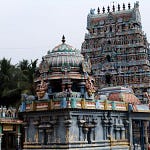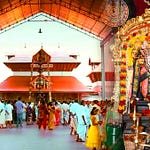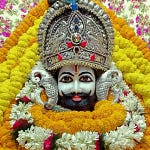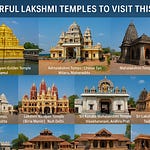1. Origin & Founding
Mythological Origin:
Kamakhya Temple is deeply rooted in Hindu mythology, especially the Shakta tradition. It is believed to be the spot where the yoni (womb) of Goddess Sati fell when Lord Shiva, grieving her self-immolation, carried her charred body and performed Tandava. To stop him, Lord Vishnu used his Sudarshana Chakra to dismember her body, and the parts fell across the Indian subcontinent forming the 51 Shakti Peethas. Kamakhya is considered the most powerful among them.
Association with Deities:
The presiding deity is Kamakhya Devi, an incarnation of Goddess Durga or Shakti. She is associated with feminine energy, fertility, and desire. The temple is unique in that it contains no idol, but instead a natural stone shaped like a yoni (female genitalia), kept moist by an underground spring.
2. Historical Timeline
Early Mentions:
First textual mention found in Kalika Purana (10th century CE), which glorifies Kamakhya as the supreme deity of Tantra.
Mentioned in Yogini Tantra, associated with esoteric traditions and Tantric practices.
Destruction & Renovation:
Believed to have been destroyed in the early medieval period, likely due to Muslim invasions.
The ruins were discovered and reconstructed in the 16th century by King Naranarayana of the Koch dynasty with the help of his general Chilarai.
The Ahom kings later supported its maintenance and expansion during their reign (17th–18th century).
3. Architecture & Design
Style:
The Kamakhya Temple is built in Nilachal style, which is a unique hybrid of Nagara and Saracenic architecture.
Features:
The main temple has a beehive-like shikhara (dome) with a sculpted image of the deity.
The Garbhagriha (sanctum) is underground and houses the yoni-shaped stone, perpetually covered with red cloth and bathed by a natural spring.
The complex has 10 temples dedicated to 10 Mahavidyas, including Kali, Tara, Bhuvaneshwari, Bhairavi, Chinnamasta, and others.
Richly carved stone walls, inscriptions, and Tantric motifs decorate the complex.
4. Spiritual Significance
Considered one of the 51 Shakti Peethas, Kamakhya is a center for Tantra and esoteric practices.
Associated with fertility, feminine power, and menstruation, making it unique.
The Ambubachi Mela, celebrating the goddess’s annual menstrual cycle, is a major spiritual and philosophical event symbolizing regeneration.
5. Puja & Rituals
No idol worship; instead, worship is offered to the yoni stone.
Daily pujas include:
Snana (bathing)
Pushpanjali (flower offerings)
Archana (chanting of mantras)
Special rituals: Kumari Puja, Bali (animal sacrifice)—though restricted now, it reflects the Tantric influence.
Priests belong to the Brahmin community of Kamrup and follow Tantric methods of worship.
6. Festivals Celebrated
Major Festivals:
Ambubachi Mela (June): Celebrates the goddess's menstruation and is attended by millions of devotees.
Durga Puja (October): Marked by Tantric and Vedic rituals.
Manasa Puja, Pohan Biya (symbolic marriage of fishes).
Peak Footfall:
Ambubachi Mela draws over 25 lakh pilgrims from across India and Nepal.
7. Bhajans & Cultural Aspects
Traditional bhajans in Assamese, Bengali, and Sanskrit are sung by local women.
Instruments like khol (drum), taal (cymbals), and harmonium are used.
Cultural events during festivals include folk dance, kirtans, and spiritual discourses.
8. Aarti Timings & Daily Schedule
Temple Opens: 5:30 AM
Morning Aarti: 6:00 AM
Bhog Offering: 1:00 PM
Evening Aarti: 6:30 PM
Temple Closes: 10:00 PM
Best Time to Visit: Early morning (for peace and darshan) or during sunset aarti.
9. Special Satsangs, Functions, or Events
Spiritual discourses are organized during Ambubachi Mela.
Occasional Tantra-based workshops or discussions.
Saints, sadhus, aghoris, and tantric practitioners visit during spiritual festivals.
Special gatherings for Navratri and Durga Ashtami.
10. Special Pujas & Mystical Beliefs
Ambubachi Mela: The temple is closed for 3 days to symbolize menstruation; reopened with ritual purification.
Kamakhya Sindoor: Believed to have healing and protective powers.
Devotees seek solutions for fertility, marriage delays, and spiritual energy.
11. Devotee Experience
Described as intensely spiritual and emotional, especially during Ambubachi.
Facilities include darshan queues, free food camps (langar), and medical aid tents during major festivals.
The air is filled with chanting, incense, and devotional music during special days.
12. Travel & Visitor Information
Location:
Situated on Nilachal Hill, overlooking the Brahmaputra River, in Guwahati, Assam.
How to Reach:
By Air: Guwahati Airport (18 km)
By Rail: Guwahati Railway Station (6 km)
By Road: Well-connected via buses, autos, taxis
Nearby Accommodation:
Kamakhya Guest House, Hotel Shreemoyee Inn, and Ginger Guwahati
Dharamshalas for pilgrims
Entry & Dress Code:
Modest attire required (preferably Indian traditional wear)
No leather items or mobile photography inside garbhagriha
Facilities:
Paid priority darshan passes
Local guides available
No official online booking; some private portals offer services
13. Other Details
Kamakhya Debutter Board manages temple operations and donations.
Donations can be made directly at the temple trust office or via designated UPI/bank accounts.
Prasadam includes laddus, fruits, and sindoor packets.
Live updates and temple news may be available via:










